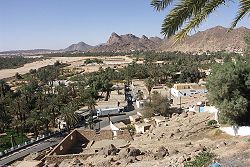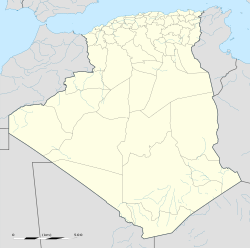Djanet(Arabic:جانت;Berber:ⵊⴰⵏⴻⵜ,Janet) is anoasiscity, and capital ofDjanet Districtas well as ofDjanet Province,southeastAlgeria.It is located 412 km (256 mi) south ofIllizi.According to the 2008 census it has a population of 14,655,[1]up from 9,699 in 1998,[2]and an annual population growth rate of 4.3%.[1]It is inhabited by theKel AjjerTuareg people.
Djanet
ﺟﺎﻧﺖ | |
|---|---|
Town andcommune | |
 A view of Djanet | |
 Location of Djanet Commune within Djanet Province | |
| Coordinates:24°33′18″N9°29′7″E/ 24.55500°N 9.48528°E | |
| Country | |
| Province | Djanet |
| District | Djanet(seat) |
| Government | |
| •PMA Seats | 7 |
| Area | |
• Total | 57,460 km2(22,190 sq mi) |
| Elevation | 1,035 m (3,396 ft) |
| Population (2008) | |
• Total | 14,655 |
| • Density | 0.26/km2(0.66/sq mi) |
| Time zone | UTC+01(CET) |
| Postal code | 33100 |
| ONScode | 3302 |


History
editThe region of Djanet has been inhabited sinceNeolithictimes. There were periods of ten thousand years at a time that the area was not desert. The flora and fauna were luxuriant as is seen in the numerous rock paintings ofTassili n'Ajjeraround Djanet. Populations of hunter-gatherers lived there.
Djanet was founded in the Middle Ages by theTuareg.TheOttoman Empire,which had a nominal authority over theFezzanregion, reinforced their presence in the area at the beginning of the 20th century in reaction to the colonization of Africa by the Europeans.
Geography
editDjanet, and the nearby towns ofAzelouaz,El Mihan,AdjahilandEferi,lie in a valley carved by the intermittent river (wadi) Oued Idjeriou through the southwest edge of theTassili n'Ajjermountain range and east of theErg Admersand dunes. TheTadrart Rougeis located to the southeast and is a southern prolongation of the LibyanTadrart Acacus.
Due to the somewhat cooler air, higher humidity and somewhat higher rainfall in these areas, the nearby mountains support a greater amount and variety of wildlife than lower-lying areas in the Sahara, and forms part of theWest Saharan montane xeric woodlandsecosystem. Djanet itself lies at an altitude of 1,035 metres (3,396 ft), but the mountains to the east and north reach as high as 1,905 metres (6,250 ft).[3]
Climate
editDjanet has ahot desert climate(Köppen climate classificationBWh), with very hot summers and mild winters. The city is extremely dry throughout the year, with an annual average rainfall of just 14.6 millimetres (0.57 in) and no month with an average of more than 3 millimetres (0.12 in).
| Climate data for Djanet (1991–2020) | |||||||||||||
|---|---|---|---|---|---|---|---|---|---|---|---|---|---|
| Month | Jan | Feb | Mar | Apr | May | Jun | Jul | Aug | Sep | Oct | Nov | Dec | Year |
| Record high °C (°F) | 31.4 (88.5) |
34.4 (93.9) |
36.2 (97.2) |
41.0 (105.8) |
49.0 (120.2) |
44.0 (111.2) |
48.5 (119.3) |
46.4 (115.5) |
42.0 (107.6) |
39.7 (103.5) |
33.4 (92.1) |
33.4 (92.1) |
49.0 (120.2) |
| Mean daily maximum °C (°F) | 19.7 (67.5) |
22.6 (72.7) |
27.2 (81.0) |
32.7 (90.9) |
36.3 (97.3) |
38.5 (101.3) |
38.4 (101.1) |
37.9 (100.2) |
36.6 (97.9) |
31.9 (89.4) |
26.1 (79.0) |
21.3 (70.3) |
30.8 (87.4) |
| Daily mean °C (°F) | 11.6 (52.9) |
14.4 (57.9) |
19.3 (66.7) |
25.0 (77.0) |
29.0 (84.2) |
31.5 (88.7) |
31.2 (88.2) |
30.9 (87.6) |
29.4 (84.9) |
24.4 (75.9) |
18.2 (64.8) |
13.4 (56.1) |
23.2 (73.8) |
| Mean daily minimum °C (°F) | 3.5 (38.3) |
6.3 (43.3) |
11.5 (52.7) |
17.2 (63.0) |
21.7 (71.1) |
24.4 (75.9) |
23.9 (75.0) |
23.9 (75.0) |
22.2 (72.0) |
17.0 (62.6) |
10.2 (50.4) |
5.4 (41.7) |
15.6 (60.1) |
| Record low °C (°F) | −7.6 (18.3) |
−3.6 (25.5) |
0.8 (33.4) |
5.7 (42.3) |
10.4 (50.7) |
17.0 (62.6) |
18.0 (64.4) |
14.0 (57.2) |
11.0 (51.8) |
5.4 (41.7) |
0.5 (32.9) |
−3.2 (26.2) |
−7.6 (18.3) |
| Averageprecipitationmm (inches) | 1.5 (0.06) |
0.8 (0.03) |
2.1 (0.08) |
0.8 (0.03) |
2.9 (0.11) |
2.9 (0.11) |
0.7 (0.03) |
1.0 (0.04) |
1.7 (0.07) |
2.0 (0.08) |
0.1 (0.00) |
0.2 (0.01) |
16.7 (0.66) |
| Average precipitation days(≥ 1.0 mm) | 0.3 | 0.2 | 0.3 | 0.2 | 0.6 | 0.5 | 0.1 | 0.2 | 0.4 | 0.6 | 0.0 | 0.0 | 3.4 |
| Averagerelative humidity(%) | 35.3 | 29.3 | 22.7 | 18.7 | 18.0 | 18.2 | 16.6 | 18.4 | 20.4 | 26.6 | 28.1 | 33.2 | 23.8 |
| Mean monthlysunshine hours | 281.8 | 265.7 | — | 288.2 | — | 303.7 | 362.1 | — | 304.0 | — | — | — | — |
| Source 1:NOAA[4] | |||||||||||||
| Source 2: climatebase.ru (extremes, humidity)[5] | |||||||||||||
Transport
editDjanet Inedbirene Airport[6]is located about 30 kilometers south of the city center.
Education
edit4.1% of the population has a tertiary education, and another 19.8% has completed secondary education.[7]The overall literacy rate is 85.6%, and is 92.1% among males and 78.0% among females, all three rates being the highest for any commune in the province.[8]
Localities
editThe commune is composed of 12 localities:[9]
- Centre Ville
- Azelouaz
- Tin Katma
- El Mihan
- Aghoum
- Adjahil
- Eferi
- In Abarbar
- Medak
- Arikin
- Tin El Koum
- Anijir
See also
editExternal links
editReferences
edit- ^ab"Population: Illizi Wilaya"(PDF)(in French). Office National des Statistiques Algérie.Archived(PDF)from the original on 13 November 2011.Retrieved16 May2013.
- ^"Algeria Communes".Statoids.Archivedfrom the original on 18 July 2017.Retrieved8 March2013.
- ^"Sabhah Sheet 8, Edition 4, AMS, 1969".University of Texas Libraries.Archivedfrom the original on 4 October 2012.Retrieved17 May2013.
- ^"Djanet Sennia Climate Normals for 1991-2020".National Oceanic and Atmospheric Administration.Retrieved9 October2023.
{{cite web}}:CS1 maint: url-status (link) - ^"Djanet, Algeria".Climatebase.ru.Archivedfrom the original on 22 June 2013.Retrieved17 May2013.
- ^"Djanet Inedbirene Airport".OurAirports.Archivedfrom the original on 18 August 2014.Retrieved17 May2013.
- ^"Structure relative de la population résidente des ménages ordinaires et collectifs âgée de 6 ans et plus selon le niveau d'instruction et la commune de résidence"(PDF)(in French). Office National des Statistiques Algérie. Archived fromthe original(PDF)on 13 November 2011.Retrieved13 February2013.
- ^"Taux d'analphabétisme et taux d'alphabétisation de la population âgée de 15 ans et plus, selon le sexe et la commune de résidence"(PDF)(in French). Office National des Statistiques Algérie. Archived fromthe original(PDF)on 13 November 2011.Retrieved13 February2013.
- ^"Décret n° 84-365, fixant la composition, la consistance et les limites territoriale des communes. Wilaya d'Illizi"(PDF)(in French). Journal officiel de la République Algérienne. 19 December 1984. p. 1554. Archived fromthe original(PDF)on 2 March 2013.Retrieved2 March2013.
